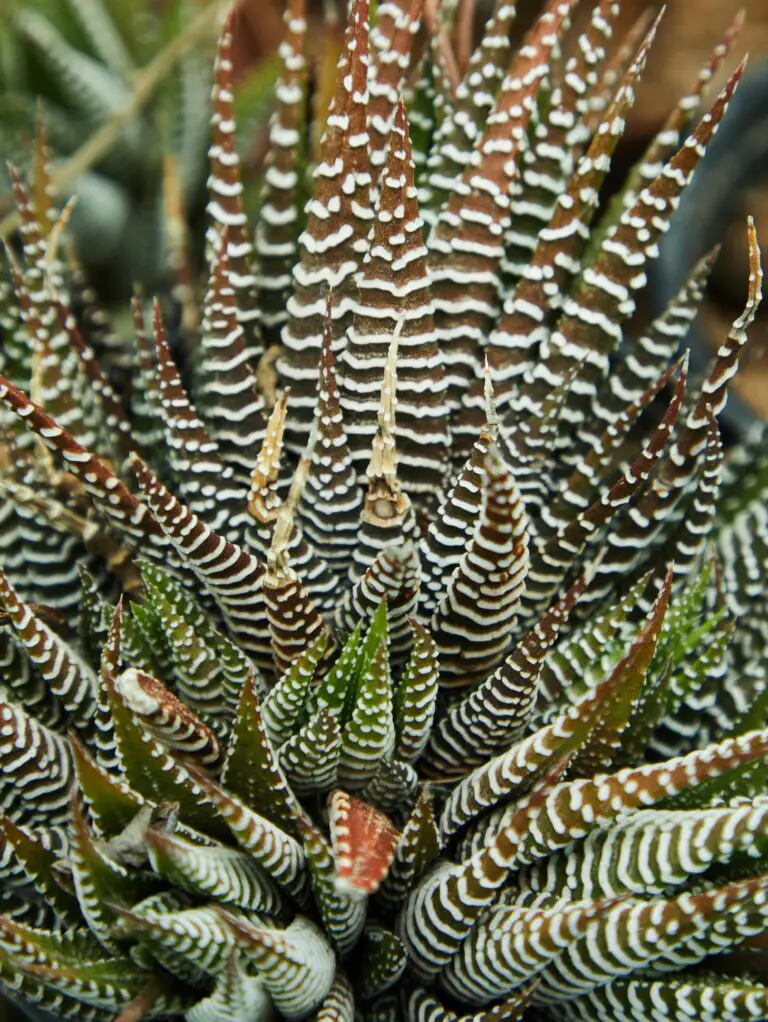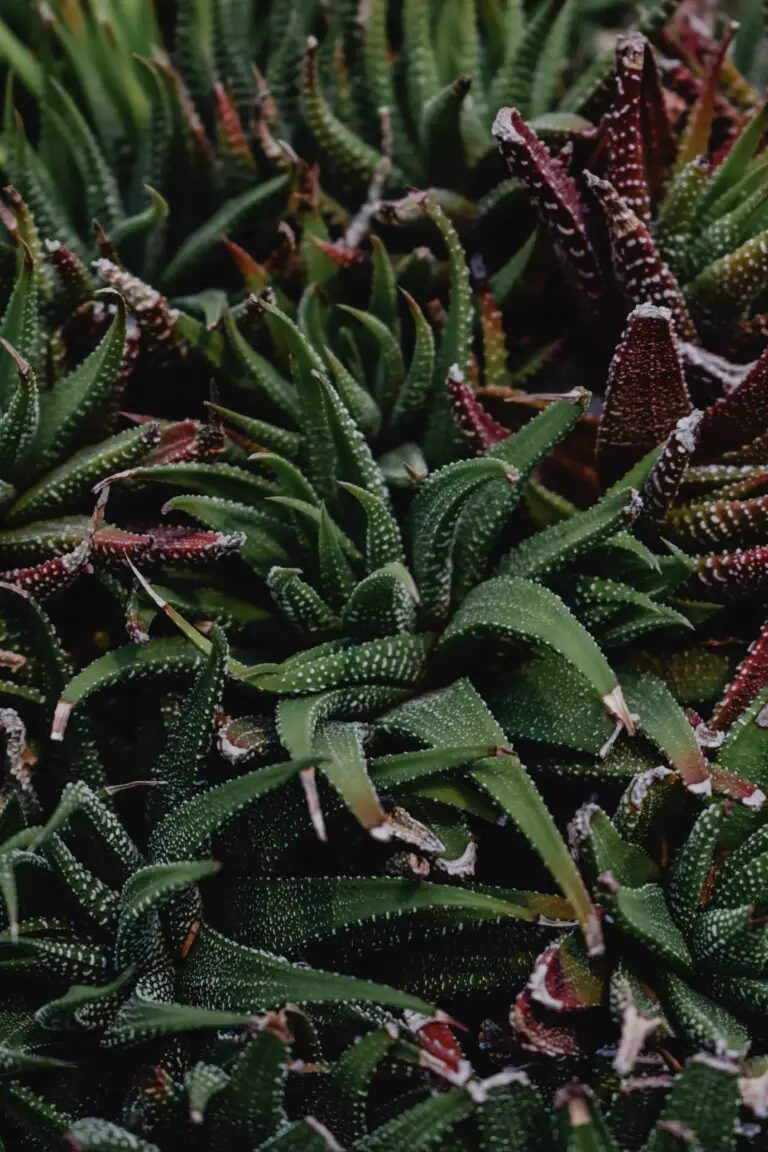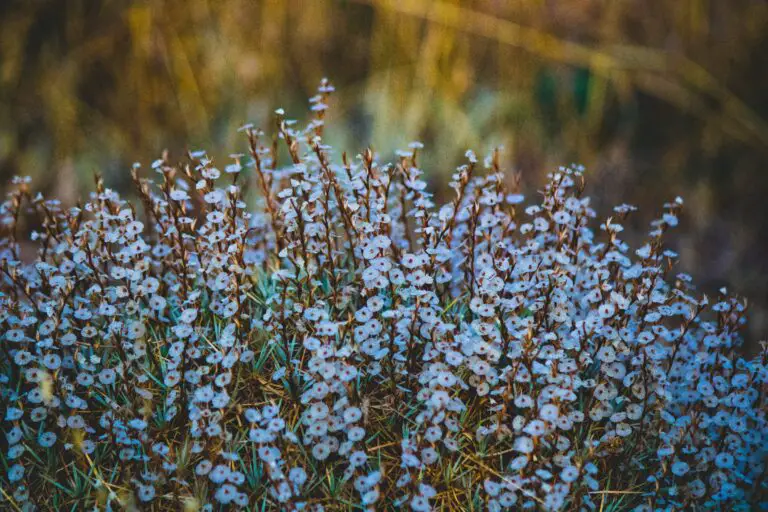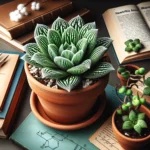Introducing the Haworthia Cooperi
Step into the enchanting realm of succulents, and you’ll soon discover the Haworthia Cooperi—a gem among its peers. This South African native is a sight to behold, with its plump, translucent leaves that glisten like morning dewdrops atop a spider’s web. But there’s more to this succulent than meets the eye. In this section, we’re diving deep into the unique world of the Haworthia Cooperi, unraveling the secrets that make this plant a treasure for succulent enthusiasts far and wide.
Distinguishing itself from the wide array of succulents, Haworthia Cooperi boasts leaves that are nothing short of an optical illusion. Imagine leaves so clear that you can peer through them, witnessing the intricate patterns of chlorophyll-rich veins—a feature that has earned it the nickname ‘window plant’. It’s a true marvel of nature how these chubby, almost spherical leaves can simultaneously act as sunlight catchers and understated decorators of any space they grace.
Why do collectors and home gardeners alike clamor for a piece of this succulent splendor? It’s simple: Haworthia Cooperi’s resilience and low-maintenance demeanor make it a perfect companion for those with a busy lifestyle or new to the world of plants. Add to that its penchant for modest growth, and you have a succulent that fits as neatly on a sun-drenched windowsill as it does in a terrarium, asserting its presence without demanding constant attention.
Real-life examples of the Haworthia Cooperi’s easy-going nature are abundant. Take, for instance, a corner desk in an office, where a lone Cooperi sits, bathing in the soft light, untouched and unfazed by the hustle and bustle of the workday. Or consider the myriad of social media posts by proud owners, showcasing their Cooperis basking in the gentle morning sun, their leaves almost glowing from the warm embrace. These living experiences showcase why this jewel of a succulent is cherished globally.
Let’s take a moment to witness the charm of Haworthia Cooperi in action. Below is a video that captures the essence of caring for and growing this delightful succulent—a must-watch for enthusiasts and curious minds alike.
As we’ve peeked into the world of the Haworthia Cooperi, it’s clear that this succulent isn’t just a plant; it’s a statement—a testament to the beauty and simplicity that nature can bestow upon our living spaces. Cherished for its translucent leaves, ease of care, and modest size, the Haworthia Cooperi continues to capture hearts, not just for its rarity but for the tranquil ambiance it adds to any environment. It’s a gem worth exploring, nurturing, and celebrating.
Distinctive Characteristics of Haworthia Cooperi
Have you ever stumbled upon a gemstone so wonderfully natural that it seems surreal? That’s the feeling you get when you encounter Haworthia Cooperi. This succulent is like a botanical treasure, with its leaves glistening like clusters of emerald crystals. Each leaf boasts a level of translucency that gives a sneak peek into the green oasis that lies within, often leaving plant enthusiasts in awe of its delicate beauty.
Imagine the soft, textured surface of a leaf that appears to have been carefully crafted by nature itself. The leaves of Haworthia Cooperi exhibit a variety of texture variations, ranging from smooth and glass-like to pebbled and detailed with tiny bristles. The versatility in texture not only adds an element of intrigue to each specimen but also reflects the plant’s adaptability to its environment.
Contrary to what their ornate appearance might suggest, these succulents are quite compact. Typically, they grow to a modest size, making them perfect companions for indoor spaces or miniature gardens where they can truly shine without overwhelming the area. Their size lends to an intimate appreciation; it’s a plant that invites you to lean in closer, to truly observe and enjoy the intricacies of its design.
When it comes to personality, Haworthia Cooperi plants are far from being one-note wonders. They remind us that in the vast world of succulents, there’s always a new marvel to discover. And Haworthia Cooperi is that captivating plant—enchanting, mysterious, and utterly mesmeric in its modest form.
Optimal Growing Conditions for Haworthia Cooperi
Envision the native habitat of Haworthia cooperi nestled in the Eastern Cape Province of South Africa, a terrain where the plant has fine-tuned its preferences and adaptations over the millennia. Mirroring these conditions in your own home or garden is key to seeing this jewel-like succulent thrive. Let’s delve into the practical guidance that will allow you to emulate the ideal microcosm for your Haworthia cooperi.
An Ode to Adequate Light
Lighting plays an instrumental role in the health of Haworthia cooperi. Mimic the dappled sunlight of its native environment by placing it in bright, indirect light. Remember, the transparent, glass-like foliage can scorch under harsh rays—think of it as the succulent’s version of a sunburn. A north-facing window or a spot with morning sun followed by afternoon shade is your best bet. You’ll witness the leaves exhibit a lively fluorescence in proper lighting, illuminating its inner secrets.
Temperature: A Warm Embrace
Remember, Haworthia cooperi is an African native, savoring the warm embrace of its homeland’s temperate climes. Although resilient, they prefer to shy away from the extremes. The comfortable realm lies between 60 to 85 degrees Fahrenheit (15 to 29 degrees Celsius). Under this canopy of warmth, your Haworthia cooperi will feel right at home, stretching out in pure contentment.
The Art of the Ideal Soil Mix
The very foundation of Haworthia cooperi‘s growth lies beneath its roots. Just as a painter selects their palette, you must mix the ideal soil—airy, well-draining, and fertile. A blend of cactus potting mix augmented with sand or perlite serves as an excellent canvas for growth. This carefully curated mixture ensures that the roots, those unseen artists, can create the stable yet breathable environment crucial for growth.
Discover the intricacies of creating this nurturing soil onour guide to succulent soil. Remember, it’s not just about providing a home for your plant; it’s about sculpting a habitat where every granule of soil plays its part in Haworthia cooperi‘s story.

In understanding and replicating these optimal conditions, Haworthia cooperi repays your efforts by gracing your space with its understated elegance. Need further insight into perfecting your care routine? Explorethis care guide and become an authority in the subtle nuances that keep your emerald treasure radiant and resilient. Step into the role of environmental artisan, and watch as your Haworthia cooperi‘s secrets unveil in the comfort of its perfectly poised world.
Watering Do’s and Don’ts for Haworthia Cooperi
Caring for a Haworthia Cooperi, while not overly complicated, involves a clever balancing act with watering. Notably, this succulent gem craves a soak-and-dry approach rather than the sprinkle-here-and-there method. Let’s dive into proper watering techniques, highlight common blunders, and share signs to watch for that scream “too much” or “too little.”
Tips for Successful Watering
Imagine you’re on a beach vacation; your Haworthia Cooperi’s roots seek a similar experience—thorough saturation followed by a period to dry out, like sand after the tide recedes. Employ bottom-watering by filling a tray with water and letting the plant drink up from the bottom. Or, if you’re top-watering, do it like a summer storm—thorough and infrequent, allowing the water to reach the bottom of the pot. Remember, it’s about mimicking the rainfall patterns in its native South Africa—occasional and plentiful.
Even experienced green thumbs can sometimes be too kind, leading to over-watering. Avoid daily waterings; Haworthias are not thirsty plants. They store moisture in their thick leaves, equipping them to handle droughts with stoic resilience. Wait until the soil feels dry an inch below the surface and then water deeply. Steer clear of shallow watering, which can encourage weak root growth—no one wants a fragile Haworthia!

Recognizing Watering Mistakes
A sunken or shriveled Haworthia may be crying out for water. These are the dramatic actors of the succulent world, visibly showing their disdain for neglect. On the flip side, over-watering leads to swollen, translucent leaves or even root rot, covertly destroying your plant from below the surface. Be attentive—changes in leaf texture speak volumes about their hydration needs.
In our comprehensive guide to succulent care, you’ll find a treasure trove of tips tailored for various succulent types. It’s essential reading for anyone looking to expand their collection beyond the darling Haworthia Cooperi.
Remember, every home has a unique microclimate, and your attentiveness to these subtle cues is key. Observing the plant’s response to your watering regimen—an art and science combined—will ensure your Haworthia Cooperi remains the jewel of your indoor garden.
Feeding and Fertilization: Boosting Haworthia Cooperi Health
Picture this: you’ve just brought home a lustrous, translucent Haworthia Cooperi, a veritable gem among succulents. It’s sitting prettily in its new pot, and you’re captivated by its beauty. But wait, it’s not just about admiring its beauty from afar. To keep your Haworthia Cooperi thriving, you’ll need to roll up your sleeves and get to the roots of its nourishment: feeding and fertilization.
First things first, let’s debunk a common myth: succulents don’t need much care. While it’s true that they’re resilient, it doesn’t mean they can subsist on a love and sunlight diet alone. Haworthia Cooperi demands its share of nutrients to flaunt that envious, healthy glow. Enter fertilizers – the secret menu for your succulent’s success.
Selecting The Right Type of Fertilizer
Stroll through any garden center, and you might feel overwhelmed by the fertilizer options available. However, when it comes to Haworthia Cooperi, think gentle and balanced. A succulent-specific fertilizer or a balanced, water-soluble blend with equal parts nitrogen, phosphorous, and potassium (typically labeled as 20-20-20) does the trick. These nutrients are the three amigos that ensure your plant has the strength for growth, the prowess for root development, and the energy for photosynthesis.
How Often to Fertilize?
Unlike your pet dog that eagerly awaits its daily feed, your Haworthia Cooperi has a more laid-back approach to dining. During its active growing season in spring and summer, a monthly feast suffices. Once fall approaches and winter’s chill sets in, your succulent prefers fasting over feasting – it’s a time for rest. So, hold off on the fertilizer to avoid overwhelming your dormant plant.
Application Methods: Tips and Tricks
Dishing out fertilizer efficiently can be likened to a well-executed magic trick. Dilute your chosen fertilizer to half the strength indicated on the package—this ensures you won’t jolt your plant with a nutrient shock. When watering, talk sweet nothings to your Haworthia Cooperi as you evenly soak its soil with the nutrient-rich solution, careful not to douse the leaves to prevent burning. Imagine you’re a gourmet chef delicately plating a dish – that’s the finesse required here.
To deliver a visual treat and walk you through the feeding process, here’s a video that showcases the essentials of nourishing your Haworthia Cooperi. Watching this video is like having a sage gardening guru by your side, imparting wisdom on achieving that perfect succulent health.
Remember, the key to your Haworthia Cooperi’s heart is through its roots. With the right fertilizer mix, a gentle hand, and a loving approach, you’ll have a vibrant, lush plant that’s a testament to your green thumb. Feed it well, and it’ll reward you by being the crown jewel of your succulent collection!
Propagating Your Haworthia Cooperi
Unlock the potential for endless greenery in your home with the art of propagating Haworthia Cooperi. It is a simple process that brings the joy of gardening right onto your windowsill. Let’s delve into the journey of turning one succulent into a plethora, shall we?
Propagating Through Offsets
Often called “pups,” offsets are the little clones that sprout at the base of a parent Haworthia Cooperi. Wait until they’ve matured and formed their own roots, then gently twist them away from the mother plant. Imagine it’s like carefully plucking a ripe apple from a tree. Plant these offsets in a well-draining cactus mix and watch them grow up to be a mirror image of their parent!

Leaf Cuttings: A Delicate Procedure
With a sterilized knife, slice a healthy leaf from the base of your Haworthia Cooperi, replicating the precision of a skilled surgeon. Allow the cutting to form a callous for a few days; this is the plant’s natural band-aid. Once healed, nestle the leaf in damp sandy soil. Patience is key—roots and a new rosette will emerge over time, a true testament to nature’s resilience.
Seeds: The Patience Game
For those who enjoy playing the long game, growing Haworthia Cooperi from seeds can be an exercise in patience. Sprinkle the seeds over a moistened cactus mix and cover them with a fine layer of sand as if tucking them into bed. Keep them in a warm, bright spot without direct sunlight—think of a cozy corner where they can slowly wake from their slumber. With constant care, these seeds will sprout into tiny succulents, a slow but rewarding process.
Propagating your Haworthia Cooperi isn’t just about plant multiplication—it’s a voyage of discovery, growth, and the sheer wonder of creating new life from the old. Watch in amazement as tiny leaves or inconspicuous seeds unfold into blooming beauties. It’s not merely gardening; it’s a tale of transformation and renewal told by your very own windowsill nursery.
Common Pests and Problems: Protecting Your Haworthia Cooperi
Imagine a verdant oasis where your Haworthia Cooperi sits as the crown jewel among succulents, its translucent, water-filled leaves outshining its siblings. Now, picture this serene kingdom under siege – by tiny invaders! Yes, even the sturdiest Haworthia Cooperi is not impervious to the whims of nature’s less favorable guests. In this vivid realm, the marauding pests emerge as the chief antagonists. Let’s dive into their world and discover ways to shield our succulent treasures.

Meet the usual suspects – aphids, mealybugs, and spider mites, critters so small they could be staging a takeover right under your unsuspecting nose. These tiny bug bandits suck the sap from the leaves, leaving behind a trail of destruction that manifests as yellowed leaves, stunted growth, and a generally lackluster appearance. It’s akin to finding your precious succulent held hostage by an invisible enemy.
Aphids: The Greenhouse Gangsters
Aphids, the sticky-fingered insects of the plant world, are notorious for leaving behind a sugary residue called honeydew. This gooey substance not only attracts other pests like ants but can also cause sooty mold to flourish, covering your plant in a blanket of black fungus. To combat these ruffians, you can introduce natural predators like ladybugs into the fray or apply a mild solution of soapy water to evict them from your greenhouse gangland.
Mealybugs: The White Fuzz Felons
If you spy a gathering of tiny white fluffs huddling in the crevices of your plant, you may have stumbled upon a mealybug lair. Resembling miniature cotton swabs turned to a life of crime, they can quickly overrun the scene if not addressed. The secret weapon? A cotton swab dipped in alcohol to dab away their white robes and disrupt their nefarious activities or a good shower of neem oil to send them packing.
Spider Mites: The Silken Sneaks
Spider mites, meanwhile, are less conspicuous in their mischief. These minuscule miscreants weave a network of fine silk over the foliage, which might be mistaken for an intricate piece of art, but is, in fact, a sign of trouble. A magnifying glass might reveal their web of deceit – literally and figuratively. An ambush with a strong blast of water or the application of miticide brings an end to their silky shenanigans.
No need for despair, for vigilance is your ally in this ongoing battle. Regular inspections are the spells that keep the dark magic of infestations at bay. Exercise a keen eye and you’ll likely spot these pests before they ever get to stage a full-blown coup. And if the invaders breach your defenses, know that an armory of organic and chemical solutions stand ready to assist you in protecting your succulent sanctuary.
Designing With Haworthia Cooperi: Aesthetic Uses and Display Tips
Imagine the perfect blend of nature and design within your living space—the Haworthia cooperi offers just that with its transparent, lime-green leaves and uniquely plump, pearly marbles, ready to turn any corner of your abode into a miniature oasis. Let’s unearth some creative ways you can showcase this succulent gem in your home.
First off, selecting the right container is critical for the visual impact. A clear glass terrarium is an excellent choice to allow observers a glimpse into the intricate details of Haworthia cooperi‘s leaves. By pairing this succulent with a minimalist stand or floating shelf, it draws the eye straight to the delicate beauty of the translucent flesh, sometimes resembling tiny green opals.
Container Ideas That Compliment Your Haworthia
Don’t be afraid to contrast the modern with the traditional. A rustic, weathered clay pot can serve as a warm juxtaposition against the cool, sleek leaves, adding an unexpected twist to a conventional display. For a more eclectic approach, why not nestle your Haworthia cooperi into an antique teacup or a whimsical fairy garden setup? Such arrangements speak to the versatility and understated elegance of this succulent.
Companion Plants and Haworthia Harmony
When it comes to companion planting, consider foliage and flowering plants with similar watering needs but contrasting textures. A feathery fern or a spiraling sansevieria can heighten the visual interest, while a splash of color from a flowering Kalanchoe can create a lively tableau. Remember, the goal is to complement, not compete — allow your Haworthia cooperi to be the star of the show.
Here’s a little insider tip: for a truly dynamic display, combine various Haworthia species. The juxtaposition of Haworthia cooperi with its cousins, like the zebra-striped Haworthia fasciata, can be quite striking. It brings together a tapestry of textures and forms, showcasing the diversity and appeal of these desert jewels.
Setting the Stage: Presentation Matters
Think of your display as a stage, and every choice you make is part of the set design. A slice of natural wood can act as a rustic stage for your succulent, while a series of small, geometric planters could create an avant-garde scene. Your haworthia can also be the crowning touch in a well-curated bookshelf display or the soothing green focal point on a sunny kitchen windowsill.
Imagine a serene bedroom with a softly lit corner showcasing your Haworthia cooperi in a hanging glass globe — a dreamy nightlight that brings comfort and a touch of nature indoors. Or perhaps it could become the main highlight at your well-organized work desk, radiating tranquility amidst the hustle of daily tasks.
With each display choice you make, keep in mind that the haworthia’s compact size and ease of care make it ideal for busy homeowners seeking a touch of greenery without much fuss. It’s not just about aesthetics; it’s about creating that perfect spot where the stress of the outside world melts away as you admire your little piece of botanical art.

Buying Guide: Selecting the Best Haworthia Cooperi Specimen
Imagine stepping into a lush greenhouse, the aroma of moist soil mingling with plant life—you’re on a quest for a Haworthia Cooperi, the jewel of succulents. As you navigate through rows of greenery, remember that not all specimens are created equal. Here’s how to spot the crown jewels among common rocks.
Firstly, eye the plant’s vigor. A robust Haworthia Cooperi boasts plump, translucent leaves arranged in a rosette, hinting at optimal health. Be wary of any discolored or shriveled leaves, as they often scream neglect or disease. Gently squeeze the leaves—resilience is a good sign, indicating adequate hydration and cell integrity.
Scrutinize the potting mix and container next. The ideal abode for a Haworthia Cooperi is a well-draining mix, avoiding waterlogged roots that spell doom. The pot should have drainage holes at the bottom, allowing excess water to escape. A suffocating plant is sadly akin to a fish out of water—not a pleasant scenario.
Turn your detective gaze to the labeling. Cultivars like ‘Truncate’ or ‘Venusta’ are not just fancy tags; they reveal the plant’s lineage and care nuances. Labels can also indicate if you’re adopting a purebred or a hybrid, each with its own charm and personality.
Don’t be shy to query the seller about the plant’s history. How long has it been nestled in that pot? What cosmic concoction of nutrients has it been sipping? Knowledgeable staff should provide a backstory worthy of this little gem, setting you up for a successful guardianship. An informed purchase is like choosing a fine wine—the backstory often enhances the experience.

Lastly, read between the lines of price tags. A suspiciously cheap Haworthia Cooperi might harbor hidden costs in rehabilitation or be a common species masquerading as its more esteemed cousin. Alternatively, a pricey plant should justify its tag with a spectacular display of health and rarity.
Armed with these insights, you’re primed to pick a Haworthia Cooperi that thrives under your care, morphing from a mere purchase to a thriving green companion with stories to tell. Each visit to the greenhouse could be a treasure hunt—with the right knowledge, you’re bound to strike gold.
Frequently Asked Questions
Welcome to the treasure trove of information on the sparkling gem of succulents, Haworthia cooperi. Below, we tackle the most pressing questions that have perched on the lips of succulent enthusiasts. Whether you’re curious green thumbs or a seasoned botanist, this section will bring light to your Haworthia cooperi queries with a natural flair for facts and a no-fuss approach to succulent care.
What Are the Optimal Conditions for Haworthia Cooperi Growth?
First and foremost, the well-being of your Haworthia cooperi begins with the right environment. Picture this: a cozy terracotta pot sitting by an east-facing window, catching the soft morning sunlight as it filters through. These jewels prefer bright but indirect light – a similar mise-en-scène to their native South African landscapes. Overexposure to direct sunlight can cause their translucent leaves to sunburn, much like a fair-skinned vacationer at the equator. Keep the soil well-draining – a mix of potting soil with added perlite or pumice works wonders – so their roots don’t sit in moisture for too long.
How Often Should I Water My Haworthia Cooperi?
Watering is like hitting the perfect note in a melody; it should be just right. For Haworthia cooperi, a good rule of ‘thumb’ is the soak and dry method. Drench the soil until water runs out the pot’s drainage holes, then wait. Be patient. Allow the soil to completely dry out before the next watering session. This dance between drought and drench prevents root rot and mimics the rainfall patterns of their homeland. Imagine receiving rain in brief, abundant bursts, followed by periods of dry skies – that’s the rhythm Haworthia cooperi moves to.
What Are Common Problems with Haworthia Cooperi and How Can I Solve Them?
Even these hardy succulents can hit a rough patch. Have you noticed your Haworthia cooperi starting to stretch out, reaching for something? That’s etiolation, a sign they’re craving more light. Gently reposition them to satisfy their light appetite but again, don’t let them sunbathe for too long. If the leaves start to go mushy, it’s often overwatering. In this case, ease up on the hydration station. Less is more. Sometimes, though, they can get thirsty. If you see the leaves puckering, it’s a cry for water. Listen to these subtle signs, and you’ll become a fluent speaker of Haworthia cooperi-ese in no time!
For a real-life example, let’s turn to Sam. Sam’s Haworthia cooperi collection is his pride and joy. Once, he noticed the tips of the leaves turning brown and crispy. Alas, a classic case of under-watering during a scorching summer. Sam adjusted his watering schedule accordingly, and his succulent friends bounced back with resilient vigor. It’s these small but pivotal tweaks in care that can make a world of difference to your little green buddies.
And now, to see these tips in action, check out this insightful video:
Armed with these FAQs, you’re now one step closer to becoming a bona fide Haworthia cooperi connoisseur. Happy planting, and may your succulents always be as plump and shiny as dewdrops on a fresh morning leaf!

